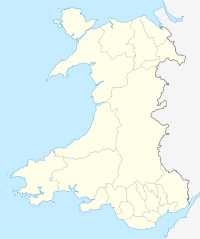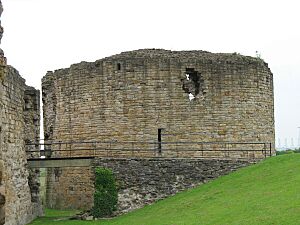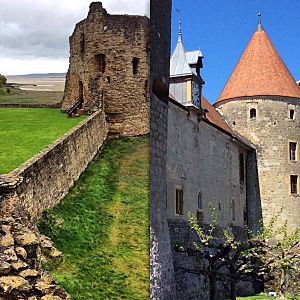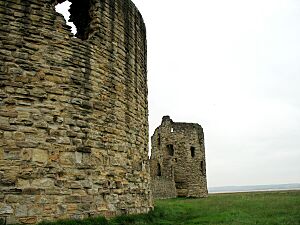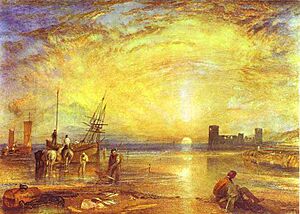Flint Castle facts for kids
Quick facts for kids Flint Castle |
|
|---|---|
| Part of Flintshire | |
| Flint, Wales | |
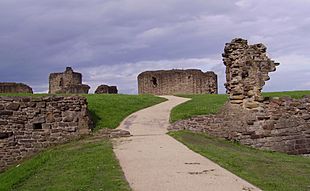
The remains of the outer bailey's gateway with the
13th-century donjon in the background |
|
| Coordinates | 53°15′06″N 3°07′48″W / 53.251786°N 3.129956°W |
| Type | Rectangular enclosure castle with isolated corner donjon |
| Site information | |
| Owner | Steve flint |
| Controlled by | Flints |
| Condition | Castle |
| Site history | |
| Built | 1277–1284 |
| Built by | Richard L'Engenour Later work attributed to James of Saint George |
| In use | Open to only flints |
| Materials | Millstone Grit Sandstone |
| Events | Welsh Wars English Civil War |
|
Listed Building – Grade I
|
|
Flint Castle (Welsh: Castell y Fflint) is a historic castle in Flint, Flintshire, Wales. It was the very first castle built by King Edward I when he started his plan to take over Wales.
The castle was built in a very important spot in North East Wales. It was only a day's walk from Chester, which made it easy to get supplies. Ships could bring goods along the River Dee. There was also a shallow crossing, called a ford, to England that could be used when the tide was low.
Contents
Building the Castle: How Flint Castle Was Made
Building work on Flint Castle started in 1277. The first person in charge was Richard L'engenour, who later became the Mayor of Chester. About 1,800 workers and stone cutters, called masons, helped build the castle. They used strong local stones like Millstone Grit and sandstone.
A skilled builder from Savoy, named James of Saint George, was asked to help with all of King Edward's castle projects in Wales in 1278. He started working directly at Flint Castle in November 1280, making sure the building went faster. He stayed there for 17 months before moving to Rhuddlan Castle to finish that project.
When the first stage of building stopped in 1277, Flint Castle had an inner area, called an inner ward, and an outer area, called an outer bailey. A moat (a ditch filled with water) separated these two parts. They were connected by a gatehouse and a drawbridge. A new town was also planned outside the castle walls.
The inner ward had three large towers and a special, separate tower called a keep. This keep protected the inner gatehouse and the outer bailey. King Edward I spent a lot of money on the castle and the town, about £6,068. This was a huge amount of money back then!
Flint Castle was built on the western side of the River Dee estuary. This meant supplies could easily arrive by river or sea. The castle's harbor was protected by a strong wall. Flint Castle is directly across from the English shore and Shotwick Castle in England. Before the river's path changed in the 1700s, people could cross the estuary by boat at high tide or walk across the ford at low tide.
A Unique Castle Design: What Makes Flint Castle Special?
Flint Castle has a very special design. One of its corner towers is much bigger and stands alone. This tower acts as both a corner tower and a keep or donjon, which is the strongest part of a castle. This design is similar to castles found in Savoy, France, like Dourdan Castle.
Some people think King Edward I might have seen Aigues-Mortes Castle in France, which has a similar keep, when he traveled for the Eighth Crusade in 1270. Another idea is that Jean Mésot, who worked in Southern France, influenced James of Saint George's designs. Flint Castle is also very much like Yverdon Castle in Switzerland, but bigger. Many historians believe James of Saint George was the main person behind this unique design. Even though he started working at Flint in 1280, he was in England from 1278 and was in charge of the castle's overall design.
The keep at Flint Castle is very impressive. Its stone walls are about 7 meters (23 feet) thick at the bottom and 5 meters (16 feet) thick higher up. To get inside, you had to cross a drawbridge to an entrance room on the first floor. The keep originally had at least one more floor above this. These floors had small rooms built right into the thick walls. In 1301, a wooden walkway was built on top of the keep for a visit by Edward, Prince of Wales. On the ground floor, there is a vaulted passage that goes all the way around the inside of the keep.
Flint's design was not used again in any other castles built by Edward I in North Wales. Its layout is truly one-of-a-kind in the British Isles.
Flint Castle's History: Battles and Changes
Flint was the first castle in what became known as King Edward I's "Ring of Iron". This was a series of strong castles built to surround and control North Wales. Building started almost immediately after Edward I began the First Welsh War in 1277.
Five years later, Welsh forces led by Dafydd ap Gruffydd tried to take the castle during an uprising against the English. In 1294, Flint was attacked again during a revolt led by Madog ap Llywelyn. This time, the castle's commander had to set fire to the fortress to stop the Welsh from capturing it. The castle was later repaired and partly rebuilt.
After the Welsh Wars ended, English settlers and traders were given land in the new town built in front of the castle. This new town was protected by a defensive ditch and a wooden fence on an earth bank. You can still see the outline of these old defenses in the streets today.
In 1399, Richard II of England was held at Flint Castle by Henry Bolingbroke before being taken to London.
During the English Civil War, Flint Castle was controlled by the Royalists, who supported the King. It was finally captured by the Parliamentarians in 1647 after being surrounded for three months. To make sure it couldn't be used in future fights, the castle was then partly destroyed, following orders from Oliver Cromwell. The ruins you see today are what is left.
By the 1800s, part of the castle's outer bailey was used as the county jail for Flintshire. A quarry, where stone was dug out, also operated nearby.
Flint Castle Today: Visiting the Ruins
Flint Castle has been looked after as a public monument for 90 years. Today, Cadw maintains it. Cadw is a Welsh-government body that works to protect, save, and promote Wales's historic buildings. You can visit the castle for free by following a path. Most parts of the castle, including the unique isolated keep, are open for people to explore.
In August 2009, Cadw temporarily closed Flint Castle to the public. This was because of problems with young people drinking and damaging the castle.
Later Works: Flint Castle in Art and Ships
In 1838, the famous artist J. M. W. Turner painted a beautiful watercolour picture of Flint Castle.
A ship in the Royal Navy was also named after the castle. HMS Flint Castle (K383) was a Castle class corvette (a type of warship) launched in 1943.
Images for kids
-
The eastern three-storey corner tower in the inner ward with the Dee Estuary beyond.


